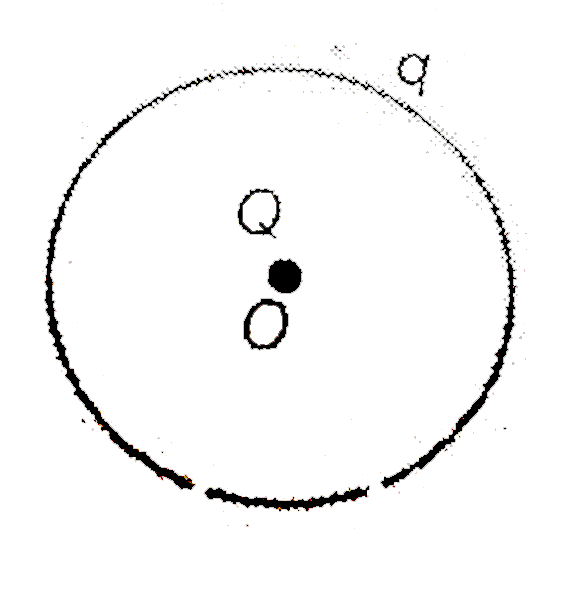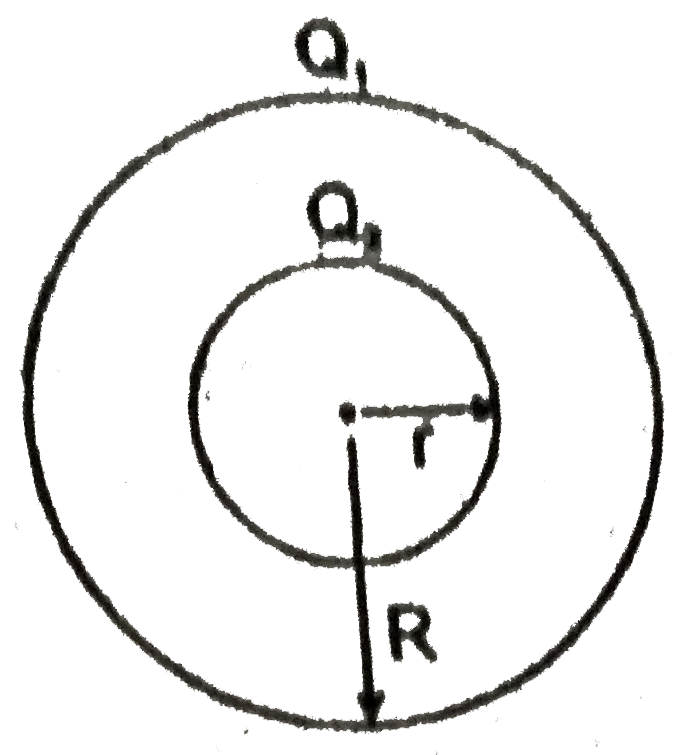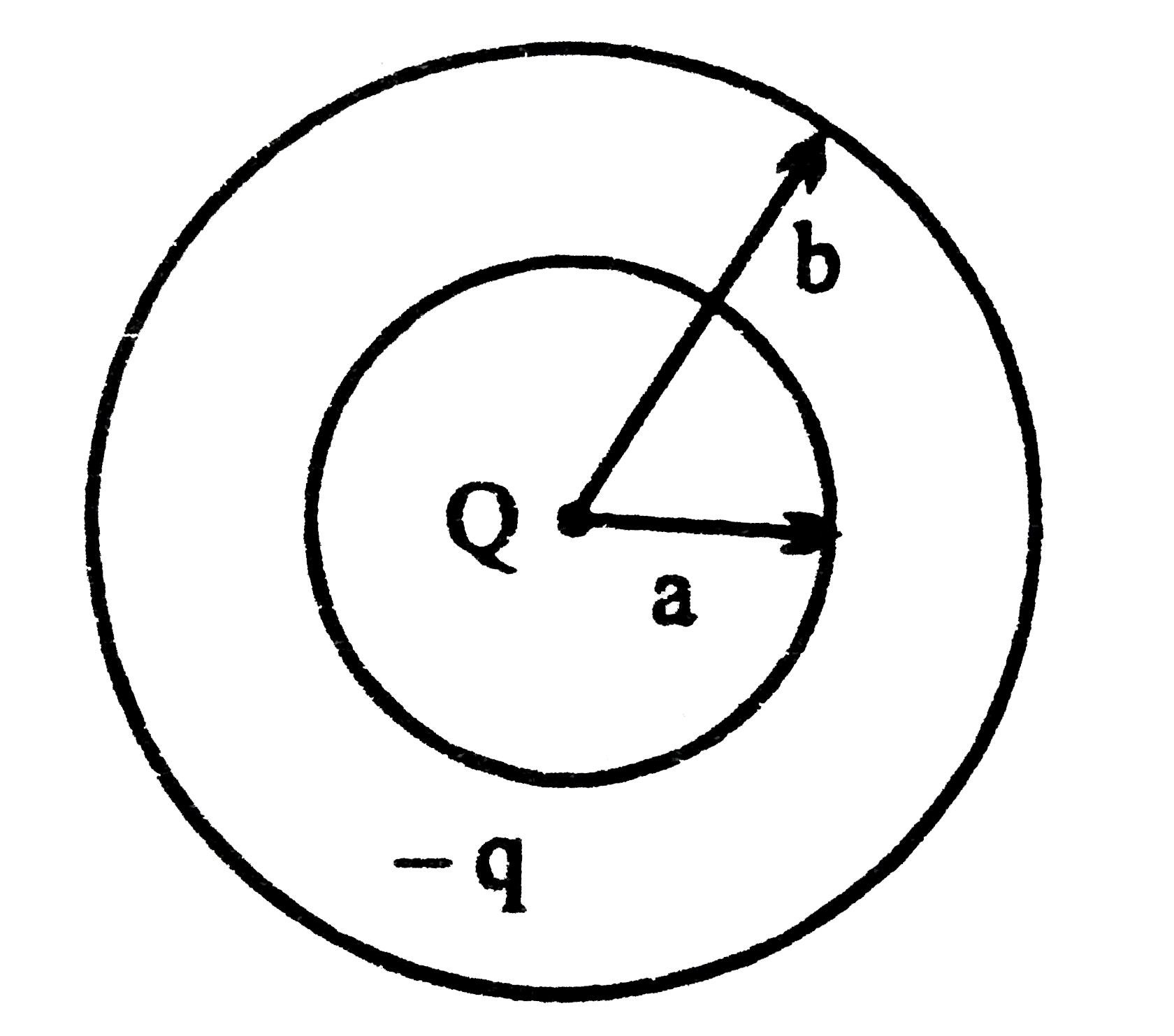A spherical conductor having charge q and radius r is placed at the centre of a spherical shell of radius R and having charge Q (R > r). The potential difference between the two is
proportional to Q
Proportional to q
Dependent on both Q and q
independent of both Q and q
The correct Answer is:B
To find the potential difference between a spherical conductor of charge q and radius r placed at the center of a spherical shell of radius R and charge Q (where R>r), we can follow these steps:
1. Understanding the System:
- We have a spherical conductor (let's call it SC) with charge q and radius r.
- This conductor is placed at the center of a spherical shell (let's call it SS) with charge Q and radius R.
2. Potential Inside the Spherical Conductor:
- The potential VSC at the surface of the spherical conductor is given by the formula:
VSC=kqr
- Here, k is the electrostatic constant.
3. Potential Outside the Spherical Shell:
- For the spherical shell, since it is a conductor, the potential outside the shell (at a distance greater than R) is given by:
VSS=kQR
4. Potential Inside the Spherical Shell:
- Inside the shell (between the inner conductor and the shell), the potential is constant and equal to the potential at the surface of the shell:
Vinside=kQR
5. Calculating the Potential Difference:
- The potential difference ΔV between the spherical conductor and the spherical shell is given by:
ΔV=VSC−VSS
- Substituting the values we found:
ΔV=kqr−kQR
6. Final Expression:
- Therefore, the potential difference between the two is:
ΔV=kqr−kQR
Final Answer:
The potential difference between the spherical conductor and the spherical shell is:
ΔV=kqr−kQR
- We have a spherical conductor (let's call it SC) with charge q and radius r.
- This conductor is placed at the center of a spherical shell (let's call it SS) with charge Q and radius R.
- The potential VSC at the surface of the spherical conductor is given by the formula:
VSC=kqr
- Here, k is the electrostatic constant.
- For the spherical shell, since it is a conductor, the potential outside the shell (at a distance greater than R) is given by:
VSS=kQR
- Inside the shell (between the inner conductor and the shell), the potential is constant and equal to the potential at the surface of the shell:
Vinside=kQR
- The potential difference ΔV between the spherical conductor and the spherical shell is given by:
ΔV=VSC−VSS
- Substituting the values we found:
ΔV=kqr−kQR
- Therefore, the potential difference between the two is:
ΔV=kqr−kQR
The potential difference between the spherical conductor and the spherical shell is:
ΔV=kqr−kQR
Topper's Solved these Questions
- ELECTROSTATIC POTENTIAL AND CAPACITANCE BOOK - AAKASH INSTITUTECHAPTER - ELECTROSTATIC POTENTIAL AND CAPACITANCE EXERCISE - ASSIGNMENT SECTION - C
53 Videos
- ELECTROSTATIC POTENTIAL AND CAPACITANCE BOOK - AAKASH INSTITUTECHAPTER - ELECTROSTATIC POTENTIAL AND CAPACITANCE EXERCISE - ASSIGNMENT SECTION - D
13 Videos
- ELECTROSTATIC POTENTIAL AND CAPACITANCE BOOK - AAKASH INSTITUTECHAPTER - ELECTROSTATIC POTENTIAL AND CAPACITANCE EXERCISE - ASSIGNMENT SECTION - A
47 Videos
- ELECTROMAGNETIC WAVESBOOK - AAKASH INSTITUTECHAPTER - ELECTROMAGNETIC WAVESEXERCISE - ASSIGNMENT SECTION - D Assertion-Reason Type Questions
25 Videos
- GRAVITATION BOOK - AAKASH INSTITUTECHAPTER - GRAVITATION EXERCISE - ASSIGNMENT SECTION - D (ASSERTION-REASON TYPE QUESTIONS)
16 Videos
Similar Questions
Electric potential at the centre of a spherical shell of radius r and having charge g is given as ___________ .
View SolutionA point charge Q is placed at the centre of a circular wire of radius R having charge q. Find the force of electrostatic interaction between point charge and the wire.

View Solution
Knowledge Check
A spherical conductor having charge q and radius r is placed at the centre of a spherical shell of radius R and having charge Q(R>r0. The potential difference between the two is
AProportional to QBProportional to qCDependent on both Q and qDIndependent of both Q and qA body of mass m is placed at the centre of the spherical shell of radius R and mass M. The gravitation potential on the surface of the shell is
A−GH(M+m)B−GH(M−m)C−GH(mMM+m)D−GH(mMM−m)A spherical shell of radius R has a charge +q units. The electric field due to the shell at a point
Ainside is zero and varies as r−1 outside itBinside is constant and varies as r−2Cinside is zero and varies as r−2 outside itDinside is constant and varies as r−1 outside it
A point charge +q is placed at the centre of a conducting spherical shell of inner radius a and outer radius b. Find the charge appearing on the inner and outer surface of the shell.
View SolutionA solid metallic sphere of radius R having charge +3Q is surrounded by a hollow spherical shell of radius 2R and having a charge −Q.
(a) Find electric field at distance r from centre of solid sphere [R<r<2R].
(b) Find potential difference between sphere and shell.
(c ) Find distribution of charge if
(i) inner sphere is earthed
(ii) inner sphere and shell are connected by a metallic wire.
View SolutionTwo uniformly charged concentric spherical shells of radius R and r, are given charges Q1 and Q2 respectively. If their potential difference is V, then it will not depends upon:

View SolutionA charged spherical conductor of radius a and charge q is, surrounded by another charged concentric sphere of radius b(b>a). The potential differece between conductors is V. When, the spherical conductor of radius b is discharged completely, then the potential difference between conductor will be
View SolutionBoth question a and b refer to the sustem of charges as shown in the figure. A spherical shell of conducting material. A point charge +Q is place at the centre of the spherical shell and a total charge −q is placed on the shell. A Charge −q id distributed on the surfaces as
 .
.
(b) Assume that the elctrostatic potential is zero at an infinite distance from the spherical shell . The electrostatic potential at a distance R(a<R<b) from the centre of the shell is .
View Solution
